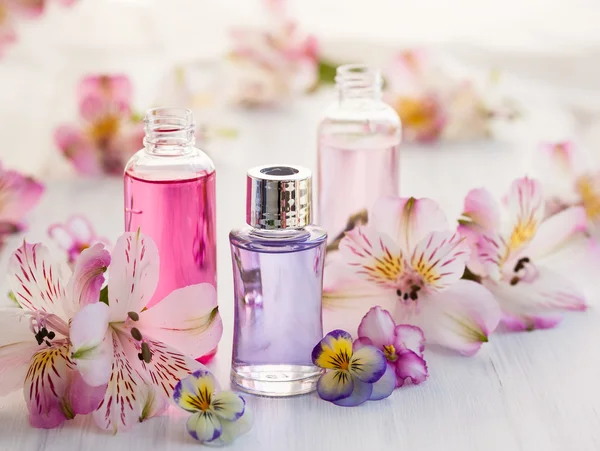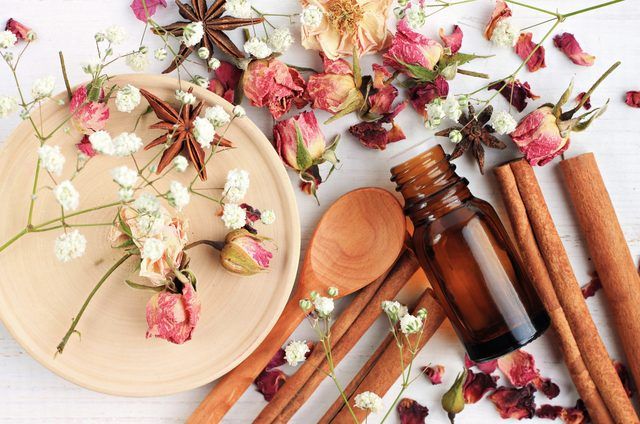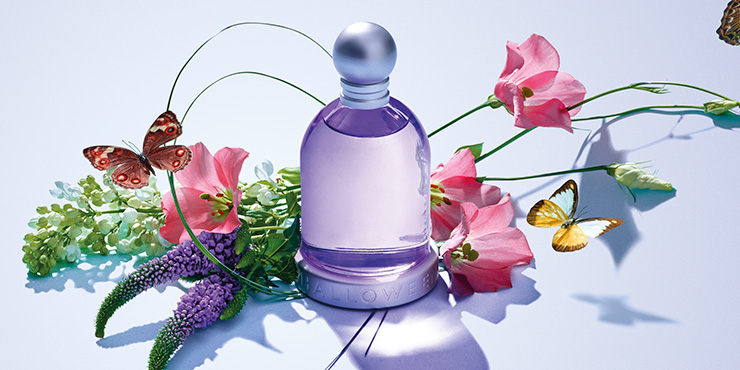Even if perfume is a beautiful gift, it is even better if it is made specifically for the recipient. How to DIY perfume? You can also create perfumes without using synthetic chemicals. Here’s how to DIY perfume with flowers, spices, herbs, and essential oils.
Scent Combinations Examples

You can, of course, combine whatever scents you choose! But to get you going, here are a few combinations:
- Earthy: Vetiver and patchouli
- Floral: Rose, violet, ylang-ylang, geranium, jasmine, and neroli
- Fruity: Lemongrass, lime, mandarin, orange, bergamot, grapefruit, and lemon
- Herbal: Clary sage, chamomile, basil, lavender, peppermint, rosemary, and angelica
- Ocean: Table salt
- Spicy: Spices such as nutmeg, cardamom, cinnamon, clove, coriander, ginger, and juniper
- Woodsy: Cedar, cypress, pine, sandalwood, and cassia
Simple Recipe For Homemade Perfume
How to DIY perfume? The simplest method for creating perfume is to combine a few drops of flavorful essential oils with the perfumer’s alcohol in a spray bottle of dark color. Because light deteriorates smells, the bottle is dark. Make sure the bottle has a tight seal because perfume evaporates and air exposure affects aromas as well! Your perfume may be as straightforward as a single essential oil diluted with alcohol, or it may include a wide variety of fragrances.
Selecting Alcohol For Fragrance
For how to DIY perfume, you may buy perfumer’s alcohol online, but you can also use vodka, Everclear, or denatured alcohol. Vodka or Everclear has the benefit of being food-grade. It is least likely to irritate the skin or take away from the fragrance of the perfume. The denaturing agent used in denatured alcohol and perfumer’s alcohol is designed to render the alcohol inedible.
Although many people use these alcohols without any problems, it’s important to keep in mind that not all denaturants are suitable for use on the skin. The use of ethanol or ethyl alcohol is crucial. The scent of isopropyl rubbing alcohol is stronger than that of ethanol. Never use methanol or methyl alcohol since they can be absorbed through the skin and are extremely harmful.
How to DIY Perfume That Lasts

The ingredients for this perfume include essential oils and base oil. It is then diluted with water and alcohol. The base oil extends the fragrance’s life. You need an oil that is gentle on the skin, smells good, and won’t go rancid, therefore not just any oil will do. Oil and water both interact with alcohol. Water can be utilized as a result since it acts as a natural disinfectant. As a result, the perfume doesn’t initially have an “alcohol-smelling” scent.
- 1/2 ounce of sweet almond or jojoba oil
- 2.675 ounces of ethanol (e.g., vodka)
- distilled water in 2 teaspoons (not tap water)
- bottle in a dark color
- 30 drops of top, 50 drops of middle, and 20 drops of base essential oils
- 4 drops of essential oils for the base note
- 10 drops essential oils with a middle note
- 6 drops of top-note essential oils
- A few droplets of the bridge notes (optional)
- Fill your bottle with jojoba oil or sweet almond oil.
- The base notes, middle notes, and top notes of the essential oils should be added in that order. If desired, add a few drips of the bridge notes.
- Alcohol is added.
- For the aroma to develop, shake the bottle and then leave it alone for two days to six weeks.
- Add 2 teaspoons of water to the perfume after the aroma is where you want it to be. To blend the scent, shake the bottle.
- A few droplets of the bridge notes (optional)
- Fill your bottle with the jojoba oil or sweet almond oil.
The base notes, middle notes, and top notes of the essential oils should be added in that order. If desired, add a few drops of the bridge notes.
Keep perfume away from heat and light in a closed bottle. Since light and exposure to air can cause many essential oils to lose their potency, you should ideally choose a dark bottle with little room for air.
Perfume Notes
Because its scent is created by an expert, perfume is one of the more expensive cosmetics. To choose the right scent combination and how to DIY perfume, you’ll need to explore, but if you’re familiar with perfume scents, you’ll be off to a good start. The note of the perfume is like the note of a song. Although the ideal combination is complex and lovely, it may not work if some notes are omitted. Top notes, middle notes, base notes, and sometimes bridges can be found in perfumery.
- Top notes: Top notes in a perfume dissipate the fastest since they have the most ephemeral fragrances. As a result, they are the first aroma you detect in perfume and the first to disappear. Top notes frequently include floral and fruity aromas. Jasmine, rose, lavender, orchid, bergamot, basil, mint, sweet orange, lime, neroli, grapefruit, and lemon are a few top-note examples.
- Middle notes: A perfume’s middle notes give it richness. After the top notes start to disappear, they continue. Geranium, clove, nutmeg, ylang-ylang, cardamom, bay, fennel, yarrow, and lemongrass are a few examples of middle notes.
- Base notes: The base notes of a fragrance establish the mood and linger the longest on the skin. Patchouli, sandalwood, vanilla, cinnamon, pine, cedar, fern, lichen, cypress, ginger, and moss are among the base notes.
- Bridge notes: Bridge notes connect other fragrance notes and have an intermediate rate of evaporation.
You can also add sea salt (which has an oceanic aroma), black pepper (which has a spicy scent), camphor, or vetiver.
The rate of note evaporation causes a perfume’s aroma to evolve over time. The order in which notes are added during the formulation of a perfume can sometimes be significant since notes can interact with one another.
How to DIY Perfume From Flower

How to DIY perfume? With fresh flowers, you may create your own fragrance. There is a straightforward method to release a flower’s fragrance into liquid, though distillation is the ideal way to create your own essential oils. Be aware that the scent of a flower that has been preserved rarely smells exactly like the scent of a fresh bloom, but it can still be enjoyable.
- 1 cup of flowers, fresh
- Half a cup of vodka
- Water distilled in two cups
- Crystal jar
After crushing the flowers to release the petals’ cells, immerse them in vodka for 24 hours. Although mashing the flowers with a spoon works just as well, an easier option is to blend the flowers and vodka.
Including the distilled water After sealing it, give it another week to relax.
To remove the particles from the liquid, either strain the mixture or use a coffee filter.
When not in use, keep the liquid in a refrigerator.
Before using, stir the mixture.
Since not all fragrance molecules are water-soluble, it is crucial how to DIY perfume from flowers to extract the scent using both alcohol and water. To ensure that oil-based components are incorporated into the liquid, some individuals mix glycerin and alcohol in the first stage. You can always add a small amount of essential oil to the finished product to boost the aroma if it isn’t as strong as you’d like.